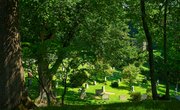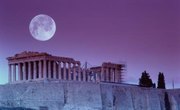Poet and artist William Blake was one of Great Britain's most original and mystical thinkers. He spent his entire life in the London he critiques in his famous poem "London." He died in poverty in 1827 and is buried near Daniel Defoe and John Bunyan in London's Bunhill Fields. Blake's imagery has influenced poets from Coleridge to mid-20th century Beat Poet Allen Ginsberg. The city is a complex symbol for Blake, and he uses London specifically to signal corruption, decay and inequality.
Charters and Marks
In the poem's first stanza, the word "chartered" is applied to London's streets as well as to the Thames River. This charged word is chosen specifically to critique early capitalism. Royal charters granted rights to corporations, universities and other bodies. Blake objected to that growing power through taxation that merchants, financiers and aristocrats were enjoying and to the financial inequality that resulted. As the speaker wanders, he notes "marks of weakness, marks of woe" among the citizens. Although many Londoners are cursed with pockmarked faces from illness, "marks" also evokes the mark of the Beast from the book of Revelation.
Widespread Conformity
In the second stanza, the word "every" is stressed five times to emphasize the widespread nature of London's misery. Nobody is exempt, as the speaker hears the cries of both adults and infants. He describes "the mind-forg'd manacles" that he hears in "every voice, in every ban." This creates a visual of a people in metaphorical chains created by collective conformity to the status quo. The word "bans" references marriage bans, including even young betrothed couples in the numbing conformity.
Exploited Youth
The third stanza presents an interesting visual play on words, because the initial letters of this stanza spell out "HEAR." This links directly to the cries of the children forced to work as chimney sweeps and the sighing soldiers described in the stanza. Churches become sooty not only literally, but also metaphorically through the Church of England's downplaying of the shameful child labor system. English soldiers in the 1790s were, like chimney sweeps, treated brutally. The blood of these young men metaphorically stains royal residence walls.
Women Victims
The curse of the young harlot in the last stanza is also both literal and figurative. Her child is the product of commerce, and she passes on venereal disease and the social and psychological effects of poverty. Her curse echoes through the last line's phrase "blights with plagues the marriage hearse." A powerful phrase, it references death for innocent wives by venereal disease. Blake has refused to leave the nuclear family out of London's corruption in this poem. The economic system in the first stanza comes full circle in the resulting prostitution of the last stanza, illustrating the need for a new social vision.
Related Articles
Writer Bio
Susie Zappia teaches humanities and research and writing courses online for several colleges. Her research interests include counterculture literature of the 1960 and instructional design for online courses and she enjoys writing about literature, art and instructional design. She holds a Master of Arts in humanities from California State University, Dominguez Hills and a Master of Science in instructional design from Capella University.











